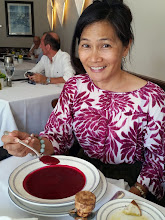I was recently invited to serve on a committee to rejuvenate the Asian Pacific Studies program at the university where I work. It doesn’t matter that I don’t eat balut or realize that “Domo arigato” is not just a lyric in a Styx song. But somehow displaying photos of half-Filipino, half-Japanese nephews alongside a small kokeshi doll collection has somehow given me street cred as an authentic Asian.
But don’t ask me if I know a good place to buy authentic Japanese tea, which Sheela did a few weeks ago after purchasing a fancy hot water dispenser for her office. The only place I could think of was Yamamotoyama at Mitsuwa Marketplace in Torrance.
I like matcha with its slightly soapy flavor and grassy green color that is often used in desserts and pastries. I enjoy genmaicha, which is the best tea to drink with a meal. But my cha of choice is Trader Joe’s Organic Green Tea, which comes in (gulp) tea bags and which I make with a cup of hot water (2 minutes and 50 seconds on the office microwave) at my desk.
We oohed and aahed over beautiful Yixing clay teapots and mysterious porcelain accessories, and puzzled over mounds of dried tea leaves that were displayed in acrylic cases and sold in prepackaged portions. Sheela chose a light variety called sayama-cha. And the requisite bag of 100 tea bags simply labeled “green tea.”

That mission accomplished, we each had a cup of green tea with apple and strolled throughout the Marketplace. Mitsuwa is a national chain with stores everywhere from Costa Mesa to Edgewater, New Jersey. However, in the Los Angeles area - including eight-year-old Seiji, who is impressed by the assortment of Japanese toys, books, and magazines offered - agrees that the Torrance outlet is the best one. Along with the main Mitsuwa Supermarket, there are smaller merchants with everything from curry-filled doughnuts to Utsuwa- No-Yakata, an upscale but affordable outlet of Japanese ceramics.

It's a doughnut. It's an entree. It's wicked good.
We started to go through the grocery store and were amused at some of the brands of products that were clearly named to mimic Western food items. I had a “Beavis and Butthead” moment laughing at cream-filled wafer cookies called, “Coque d’Asses.” And I called Jolene to ask which instant coffee she favored the most. She recommended the ubiquitous Blendy, which I have to say will change your mind about instant coffee.

"Heh, heh. She said, "asses."
Sheela said we should check out the baby food because she had read an article about Gerber products in Japan. They didn’t carry Gerber, but had several jars of a Japanese brand that reflected the more native tastes favored in Japan. Instead of peas and carrots, Japanese babies are started out with daikon, fish, and hijiki.

These sound good to me now, but probably would have seemed strange to me as a child. But then again, I’ve had them in solid form.
My sister made most of the food that Seiji and Kenzo ate as infants, pureeing traditional Japanese foods like kabocha and saba with rice.
What we eat as children undeniably guides our palate later in life. Sheela, who is an Indian American, doesn’t like barfi, the colorful Indian sweets made with condensed milk and a variety of nuts and flavorings. I don’t like halo halo, which could be considered the national dessert of the Philippines with its syrupy fruits and again, the sweetened condensed milk that seems to be the dessert topping of choice throughout Asia and Southeast Asia. We both like the traditional Japanese sweet mochi, which ironically is now made with “exotic” ingredients like good old American peanut butter.

Wonder what this would be like with grape jelly.
While Sheela and I were both weaned on solid American diets – she grew up in Ohio, she had no choice – what we did both gain was a hybrid sensibility toward food. Although we might not always embrace our parents’ native cuisine, the exposure to it does make us more adventurous toward any food of other cultures.
This is a laudable quality in others as well. I often wonder what it would be like to live in a place that didn't have the exotic culinary options that Los Angeles offers, where the mingling of many cultures results in culinary assimilation. We explore and bond over other cultures. Case in point: Sheela bought a box of Giant Pocky for her Mexican-American friend who learned about the chocolate-coated cookies from her Chinese stepmother. As John Mellencamp would say, ain't that America.

The prize of the day for me was a chocolate covered doughnut from Hamada-Ya Bakery. While this may sound fairly pedestrian, it is the size of a small tire, a light but not-too-greasy ring topped with a very thick confectioner’s quality chocolate glaze. Only a cross-cultural exchange of ideas – namely the Asian obsession with French pastry – can bring us all together. It’s a small world, after all.






No comments:
Post a Comment